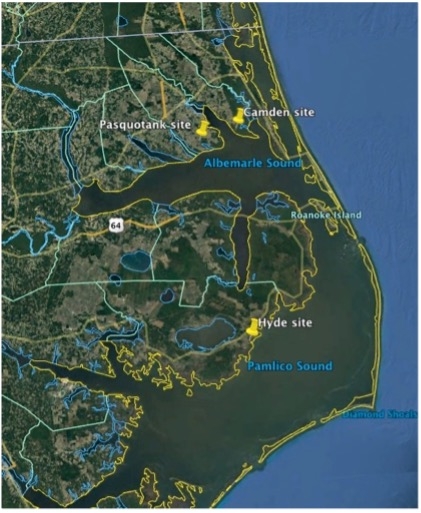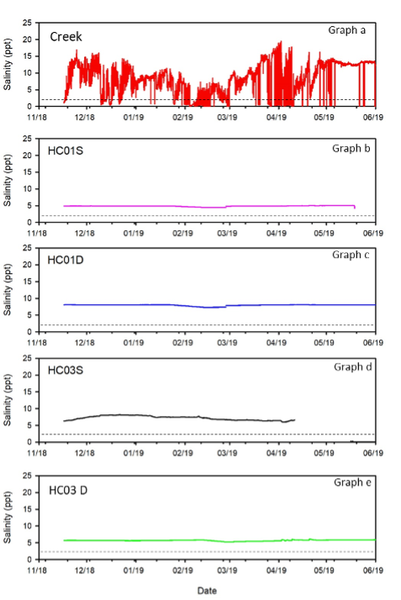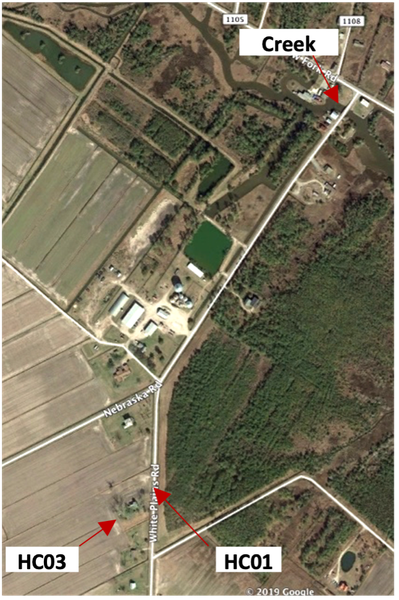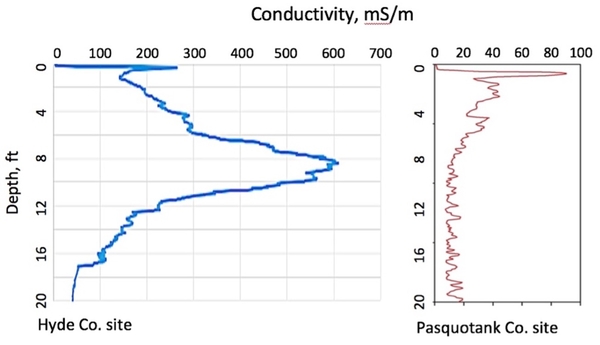Saltwater intrusion is the process by which saline water moves into freshwater systems. This process poses a significant threat to North Carolina’s coastal agricultural lands, impacting soil health, crop productivity, and the livelihoods of farmers. Soil salinization is the process by which salts accumulate in the soil at levels that are detrimental to plant growth. Salts are attracted to the soil particles and accumulate in the soil, causing toxicity to nonadopted plants. Excessive salt may also cause clay dispersion and surface sealing, impeding soil drainage. In North Carolina, the main salinization mechanisms are storm surge events, wind-driven flooding through ditch and canal networks, sea level rise, and lateral saltwater movement through the subsoil.
Measuring Salinity in Groundwater, Surface Water, and Soils
To safeguard North Carolina’s agricultural productivity and soil health, it is essential to identify affected areas and address saltwater intrusion. Researchers studied the effects of saltwater on soil, creeks, and groundwater in and along North Carolina agricultural fields in the coastal counties of Hyde, Pasquotank, and Camden (Figure 1). Well clusters and nearby creeks were used to determine vertical and horizontal variability in salinity of the water. Figure 2 provides data, presented in five graphs, obtained from the Hyde County location. The salinity in the creek (Figure 2A) was highly variable—from 0 to 20 parts per thousand (ppt)—during a seven-month period. The salinity of the water in both well clusters was constant over the same period (Figure 2B, C, D, and E) but higher than the maximum salinity recommended by Brouwer et al. (1985) for irrigation water (2 ppt), represented by dotted lines in Figure 2. The salinity in the well cluster located at site HCO1 was higher at greater depth (9 feet) (Figure 2C) than at shallower depth (3 feet) (Figure 2B); the inverse was observed at the well cluster located at site HCO3 (Figure 2D and E). Thus, salinity in the groundwater varied by depth and location, even when the wells were located relatively close to one another (Figure 3). Elevated salinity levels in the shallow groundwater indicate the potential for salts to negatively affect the crop performance at this location. The elevated salinity in the groundwater also indicates that it will be difficult to flush the excess salts from the soil profile.
A direct current electrical resistivity technique was used to map variations of resistivity in the subsurface. Figure 4 shows the soil conductivity (conductivity is the inverse of resistivity) at two sites, one in Hyde County and the other in Pasquotank County. High soil conductivity values may signify the presence of salts in the subsurface. The Pasquotank County site had a moderate reading of conductivity in the top 5 feet of soil, whereas the Hyde County site had a very high reading of conductivity between 8 and 10 feet deep. Both profiles showed a sharp increase in conductivity within the top 6 inches, indicating salt accumulation at or near the soil surface.
Identification and Potential Remediation Options for Salt-Affected Soils
Saltwater intrusion and soil salinization affect a significant portion of cropland in northeastern North Carolina, with limited adaptation methods available for farmers. Establishing the extent of soil salinization first typically involves (a) observing signs of salt presence in the field, (b) recording of reduced crop yields, (c) conducting tests to measure salinity levels in the soil, and (d) water quality monitoring. Visual indicators such as white crusts on the soil surface or abnormal plant growth (stunted plants, leaf chlorosis, and leaf necrosis) can also suggest salinity issues. Farmers may respond through physical adaptation, crop choice adjustments, land abandonment, or a combination of these options.
Identify the Problem
Visual Inspection
Farmers can visually inspect their fields for signs of salt damage, such as white crusts on the soil surface or abnormal plant growth. These visual indicators can suggest the presence of soil salinization.
Crop Performance
Monitoring crop performance can also help identify salt intrusion related issues. Salt-affected crops may exhibit symptoms such as stunted growth, small and yellow leaves, death of leaf margins, and lower yields. Observing patterns of crop damage across the field over many crop cycles can provide insights into the extent and severity of the soil salinization problem.
Soil Testing
Good soil sampling techniques can help determine the cause of decreased productivity in a field (see the NC State Extension SoilFacts publication AG-439-87, Effects of Wind-Induced Sodium Salts on Soils in Coastal Agricultural Fields). To effectively assess the extent of soil salinization, collect and analyze soil samples from salt-affected and non-affected areas. Visual inspection of the field and crop performance indicators can help pinpoint sampling locations and guide comparison between affected and unaffected areas.
The soil samples would then be sent to a laboratory for testing, such as the North Carolina Department of Agriculture & Consumer Services (NCDA&CS) Agronomic Division lab that assesses SS-I upon request. The soil test report will provide information on the exchangeable sodium percentage (ESP) and the soluble salts index (SS-I). In North Carolina, crop damage has been observed in fields with ESP levels of higher than 15% and SS-I ranging from 50 to 120, depending on the crop species and variety. Ongoing research in Hyde County is showing SS-I thresholds of 70 and 120 for non-tolerant and tolerant soybean varieties. The NCDA&CS Agronomic Division lab informs Na and ESP in soil test reports of “predictive” and “diagnostic” soil samples. However, SS-I is determined only in “diagnostic” soil samples submitted by an N.C. Cooperative Extension agent through the Diagnostic Samples Extension Program upon request.
Water Quality Monitoring
Monitoring the quality of irrigation water sources such as well (groundwater) and surface water can help farmers assess the potential risk of salt intrusion because high levels of dissolved salts in irrigation water can contribute to soil salinization over time. By combining multiple indicators and assessment methods, farmers can effectively identify salt intrusion related problems and implement appropriate management strategies to mitigate their effects on crop productivity and soil health.
Potential Remediation Options
Apply Gypsum
Gypsum applications have been used in the western desert states to address salt accumulation from irrigation and it has also been tested in some eastern North Carolina fields after storm events. The calcium in gypsum theoretically displaces soil-bound sodium, which remains dissolved in the soil solution unless flushed out by water movement. Successful gypsum treatment requires ample fresh water and adequate subsurface drainage to flush out sodium. In areas like northeastern North Carolina with inadequate drainage, high water tables, and elevated groundwater sodium levels, gypsum treatment may be less effective. However, in fields with efficient water drainage, incorporating gypsum and saturating the field with freshwater before draining it can alleviate the salinization.
Conduct Deep Tillage
Deep tillage has remediation potential in areas where surface crusts have formed but there is no accumulation of salts deeper into the soil profile. Tillage distributes and dilutes the salts, lessening their impact on the plants. Since salts will gradually be mixed deeper and deeper into the profile, deep tillage cannot be continually used unless salts are flushed entirely below the rooting zone. However, this alternative may not be ideal for low elevation or high water table areas. To evaluate the potential of this remediation strategy for a given field, it is necessary to collect and analyze soil samples at different depths within the plowing layer to determine the concentration of salts in different layers.
Crop Choice Adaptation
Farmers can adjust their crop selection by planting alternate crops or plants that are more resilient to salinity. Crops vary in their tolerance to salinity (Table 1). Variety trials in northeastern North Carolina showed that asparagus performed well in a test plot despite salty conditions. Cotton is considered highly salt-tolerant among field crops in the region. While certain soybean varieties can excrete salt from their roots, their suitability for northeastern North Carolina remains unclear.
Land Management Practices
Implementing conservation practices such as contour farming, mulching, and cover cropping can help to reduce soil erosion and minimize salt accumulation.
| High Tolerance | Medium Tolerance | Low Tolerance | |
|---|---|---|---|
| Field crops | Barley, sugar beet, rapeseed, cotton | Rye, wheat, oats, rice, sorghum, corn, flax, sunflower, castor beans, soybeans | Beans |
| Forages | Alkali sacaton, saltgrass, Nuttall’s alkaligrass, bermudagrass, Rhodes grass, Canada wildrye, western wheatgrass, barley, birdsfoot trefoil | White sweet clover, perennial ryegrass, mountain brome, strawberry clover, dallis grass, sudangrass, hubam clover, alfalfa, tall fescue | White clover, meadow foxtail, alsike clover, red clover, ladino clover, burnet |
| Vegetables | Asparagus, spinach | Tomato, broccoli, cabbage, bell pepper, cauliflower, lettuce, sweet corn, potatoes, sweet melon | Radish, celery, green beans, strawberries |
| Fruit crops | Date palm | Pomegranate, fig, olive, grape | Pear, apple, orange, grapefruit, prune, plum, almond, apricot, lemon, avocado |
*In each class, crops are listed in order of salt tolerance being from high to low tolerance.
Source: Diagnosis and Improvement of Saline and Alkali Soils, U.S. Department of Agriculture, Agricultural Handbook No. 60, 1954. ↲
Physical Adaptation and Aggressive Water Management
Dikes and floodgates or tide gates (Figure 5) can reduce the risk of additional salt inputs to fields from storm surges. Managing water-control structures to retain rainfall on fields flushes the soil with freshwater and enhances the downward leaching of salts. Repeated cycles of freshwater flooding, drainage, and reflooding will maximize salt removal.
Acknowledgments
Funding for this research was obtained from an NC State Extension Gore Innovation Grant and a National Science Foundation RAPID grant, award #1902385. Research was conducted in collaboration with N.C. Cooperative Extension agents and specialists, Camden Soil and Water Conservation District personnel, East Carolina University faculty and students, and cooperating crop producers.
We would like to thank to Carl Crozier and Diana Rashash for their contribution to previous version of this factsheet.
Reference
Brouwer, C., A. Goffeau, and M. Heibloem. 1985. “Irrigation Water Quality.” In Irrigation Water Management: Training Manual No. 1–Introduction to Irrigation, Chapter 7.6.1. Food and Agriculture Organization (FAO) of the United Nations.
Publication date: Aug. 21, 2020
Reviewed/Revised: July 18, 2024
AG-439-89
N.C. Cooperative Extension prohibits discrimination and harassment regardless of age, color, disability, family and marital status, gender identity, national origin, political beliefs, race, religion, sex (including pregnancy), sexual orientation and veteran status.





